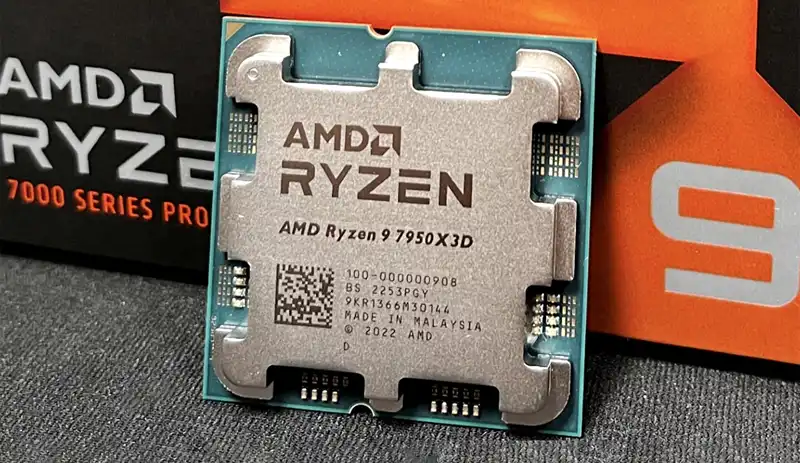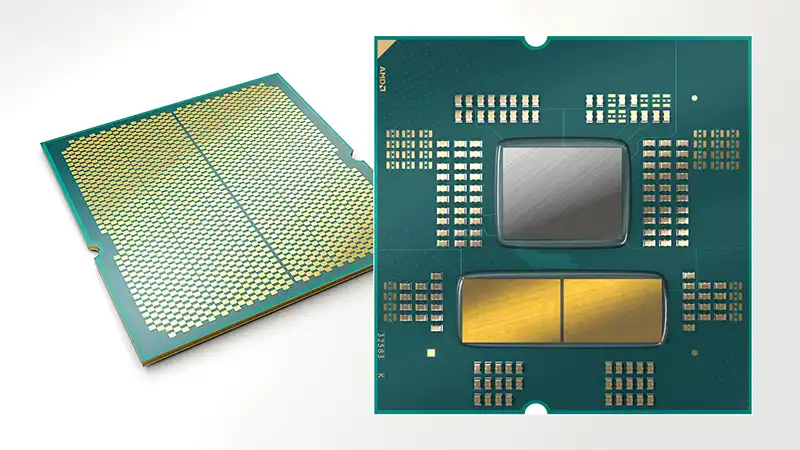You can also be interested in these:
- AMD X570 vs X570S: What is the best AMD chipset?
- Who leads the battle of the CPUs in 2023?
- AMD Ryzen 7000X3D: What to expect from these new CPUs?
- AMD Zen 3 vs Zen 4: The evolution and revolution
The arrival of 3D V-cache memories for Zen 4 processors marks the release of the AMD Ryzen 9 7950X3D, which promises to break all performance records in gaming achieved by a series processor. Current news suggests it will succeed and even surpass the Intel i9-13900K, but we should keep an eye on the 7800X3D, which has previously demonstrated superiority in this field. With 96 MB of 3D cache, 16 cores and 32 threads capable of reaching 5.7 GHz, and an ECO mode that will surprise everyone, it’s time to begin our analysis.

The most powerful gaming processor
Since the debut of the Zen 4 architecture with its 5 nm die, the world’s attention has been focused on the models that would feature 3D cache memory. The success of the AMD Ryzen 7 5800X3D experiment swept away the competition in pure gaming performance. The AMD Ryzen 9 7950X3D represents the culmination of this architecture, combining its 16C/32T of incredible raw performance with the cache memory block.
Initially, three models will be presented with this technology: the flagship 7950X3D, the AMD Ryzen 9 7900X3D with 12 cores, and the promising AMD Ryzen 7 7800X3D, whose previous version already demonstrated superior gaming performance due to its 8 cores being more suited to current graphic engines.
The design and exterior construction of the AMD Ryzen 9 7950X3D is identical to the version without 3D cache. It features an LGA socket with “little pins,” leaving the CPU with a flat base and 1718 gold-plated contacts divided into two rectangles with a central division. The peculiar IHS at the top is glued to the substrate and soldered directly to the chipsets to protect them and conduct heat to the heatsink. Its contact area is reduced, adopting 8 rectangular slots on its edges, nicknamed “octopus legs” to improve cooling by leaving out capacitors.
The AM5 socket on the motherboard is similar in mechanics to Intel processors, operated by a lever-bracket system, and measures 45x45mm. Although it has remained the same in terms of heights and types of grip for the heatsink as the previous AM4 socket, it has been changed to improve resistance to higher TDPs of CPUs with more contacts and to reserve some of them for ECC memories. Therefore, any heatsink from the previous generation will work on this new generation.
Both these CPUs and their rival’s CPUs are extremely demanding on heatsinks due to high clock frequencies and consumption, requiring a block with high thermal conductivity. However, the AMD Ryzen 9 7950X3D is less demanding in this aspect due to having a slightly lower TDP. Despite this, we still recommend using a high-profile heatsink or a good quality liquid cooling system.
Zen 4 architecture integrating 3D cache memory, the future of CPUs?
The AMD Ryzen 9 7950X3D belongs to the Zen 4 (Raphael) architecture, based on a 5 nm TSMC manufacturing process, which promises the best power/consumption ratio. Units with 3D cache memory have been implemented, which can provide up to 30% more performance in games, though not in all cases. As a very recent and innovative architecture, it is not without limitations.

Chiplet and core configuration
Before we delve into the big news, it is important to note that the AMD processor consists of three chiplets, also known as CCDs. In this generation, the processing cores and cache memory blocks have been unified, which make up the CCX. The third chiplet is the CIOD, which is the input/output interface for RAM memories and PCIe lanes, and is based on a 6 nm manufacturing process.
We have 16 processing cores and 32 threads active, which is the maximum capacity of the CPU, utilizing Simultaneous Multithreading (SMT) technology. The CPU is configured with slightly reduced frequencies compared to the Ryzen 9 7950X, with a base clock of 4.2 GHz (300 MHz less) and a boost frequency of 5.7 GHz on the most active core (the same as the 7950X). Tests show that in stock configuration, this CPU can keep all cores at 4.9-5.0 GHz, while the 7950X can go up to 5.2-5.25 GHz, resulting in slightly lower raw performance.
The reduction in frequencies across all cores is due to the 3D cache implementation, which is a much more sensitive block to changes in voltage, consumption, and temperatures. Therefore, manual voltage or frequency overclocking is not supported on this CPU, and although it is unlocked, Precision Boost Overdrive or Curve Optimizer with auto overclocking mode are the only options for improving performance. The Curve Optimizer probes the best voltage and frequency values for the cores based on consumption to adjust PPT, TDC, and EDC values.
3D cache memory
The AMD Ryzen 9 7950X3 is equipped with 3D memory, which is a memory block of 96 MB implemented directly on a single chiplet. While this mechanism is not as effective as distributing the capacity in the two CCXs, it creates a balance between difficulty and implementation costs, making it easier to use the CCX without 3D cache for applications that require a higher processing frequency.
The chipset driver manages and integrates the 3D V-cache memory with the Infinity Fabric bus and other memories, which is crucial for its proper functioning. It dynamically modifies the preferred cores for the operating system based on the preference of load for the 3D V-cache to evaluate performance. If the 3D block is not required, the normal CCX will be used preferentially. However, all cores can be used at once if necessary, or only the 3D V-cache CCX can be used in games to maximize performance.
The configuration of the normal cache memory in the second CCX has not changed compared to the 7950X. It still consists of a 16 MB block with 1 MB of L2 cache in each core and 64 KB for each core (32 KB L1D + 32 KB L1I). In total, the CPU has 144 MB of memory when adding L2, L3, and 3D V-cache. The Infinity Fabric maintains its 16-bit/cycle write bus and 32-bit/cycle read bus.
Implementing 3D cache makes the CPU more sensitive to consumption and temperatures, which is why some parameters have been slightly adjusted compared to the 7950X. The base TDP of the AMD Ryzen 9 7950X3D is set at 120W, and the maximum PPT configuration is 162W (compared to 230W on the 7950X). It also has an EDC of 180A and a TDC of 120A. The TJMax is set at 89ºC, which is considered a safe operating temperature for the CPU. AMD does not consider this temperature to be “high.”
Chiplet I/O and RAM memory
The AMD Ryzen 9 7950X3D’s I/O chiplet remains unchanged from the regular Zen 4 models, manufactured on a 6nm TSMC process. The chiplet includes an Infinity Fabric block that enables data exchange with the CCD (fclk), which receives a 32-bit/cycle bus from the memory controller (uclk) and a 64-bit/cycle bus from the I/O port controller (lclk). It also includes a third synchronization element (SyncFIFO) for fclk and uclk, facilitating smoother data transfer.
Compared to Zen 3, the I/O die in the AMD Ryzen 9 7950X3D incorporates new features such as integrated RDNA 2 graphics, with support for HDMI and DisplayPort, and added AV1 decoding and H.264/H.265 encoders/decoders. Even though the CPU is designed for gaming, the integrated graphics remain activated, making it an APU. However, it may not be useful without discrete graphics.
AMD has introduced a new technology called AMD EXPO, which is similar to Intel XMP but is open-source. It offers DDR5 RAM memory profiles and is optimized for both platforms separately, with compatibility for both types on both BIOS and motherboards. The Zen 4 architecture modifies the clock ratio between the CPU and RAM, finding the sweet spot with a 2:3 Infinity Fabric clock ratio in fclk: memclk and a 1:1 ratio in fclk: uclk.
The I/O module on the AMD Ryzen 9 7950X3D has a considerably increased capacity, offering 28 PCIe Gen5 lanes. These lanes are divided into 4x for the link with the chipset (Downlink in PCIe Gen4 mode), 16x for graphics cards or expansion slots, and 8x for NVMe SSD or expansion. It also supports up to 4 10 Gbps USB ports natively and 1 general-purpose USB.
Final words about the AMD Ryzen 9 7950X3D
The AMD Ryzen 9 7950X3D is a highly impressive processor that meets all expectations for 2023. With 128MB of L3 cache memory, it is primarily designed for gaming, but still retains its raw performance, despite a small 200 MHz decrease in clock frequency. Not only does it comfortably secure the top spot on our gaming list, but it also boasts the best consumption/performance ratio, with much more worked-on voltage adjustment to address sensitivity to vdroop and substantially improved temperatures.
Despite losing the ability to manually overclock, the CPU’s efficiency is still impressive, particularly when consumption is reduced. At a PPT of 88W, it maintains its FPS in games with minimal loss, thus achieving excellent efficiency and improved temperatures.
More stories like this
- AMD X570 vs X570S: What is the best AMD chipset?
- Who leads the battle of the CPUs in 2023?
- AMD Ryzen 7000X3D: What to expect from these new CPUs?
- AMD Zen 3 vs Zen 4: The evolution and revolution
- AMD Radeon R9 M280X GPU review: Powerful and affordable
- All about the AMD Ryzen 7 5800X3D processor
